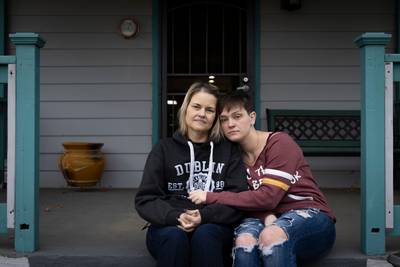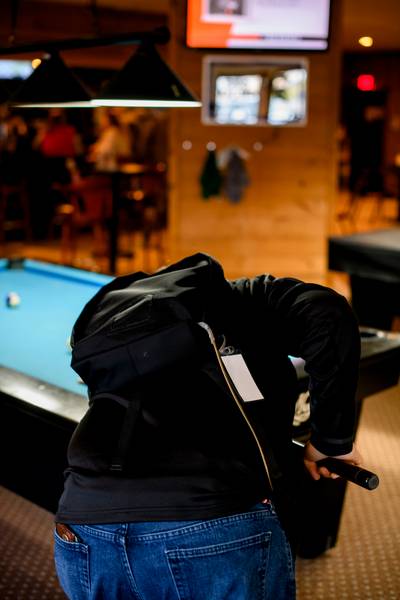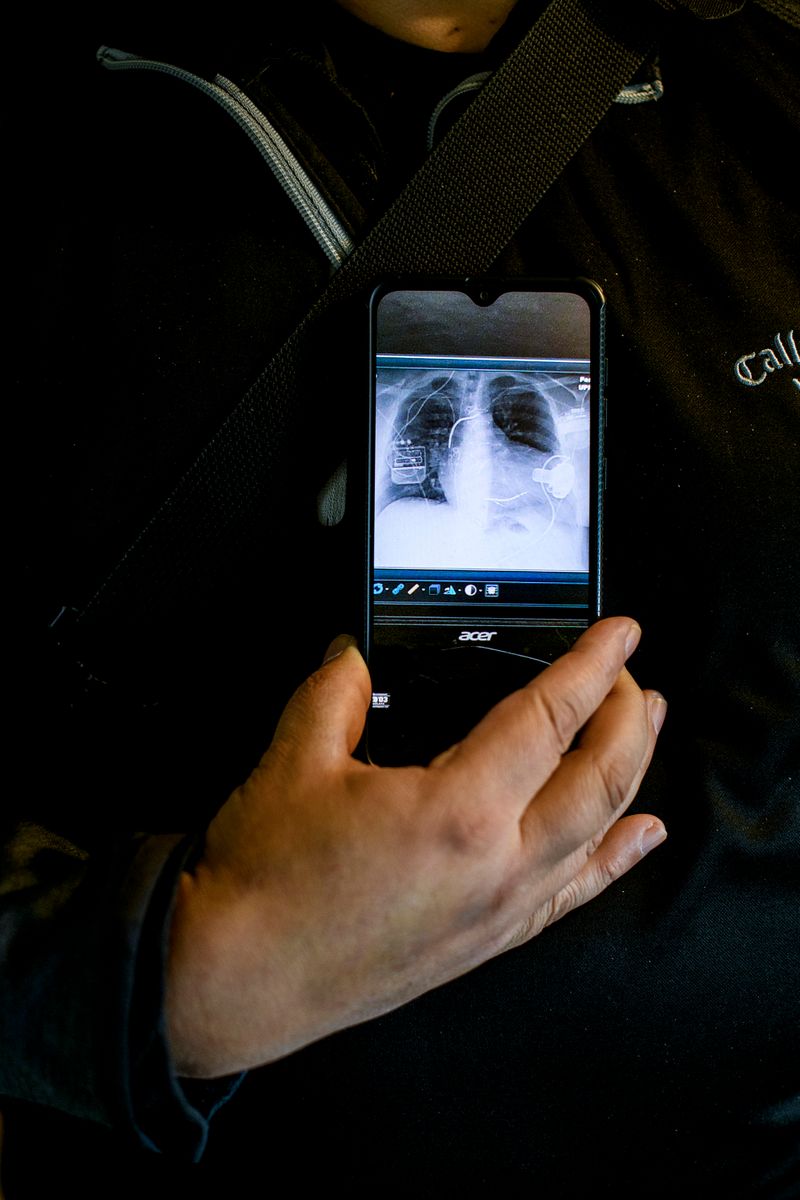
Series: HeartWare
Deadly Malfunctions, FDA Inaction and Vulnerable Patients
For the roughly 2,000 Americans who rely on it to keep their hearts going, the implanted pump is impossible to ignore.
They feel it pressing inside their ribs when they lean over. Or they ache from the weight of its controller strapped to their shoulders. Some can even hear the device’s whirring hum deep inside their chests.
Most of all, they now live with the stress of knowing the HeartWare Ventricular Assist Device has such serious issues — a higher rate of deaths and strokes than an alternative pump and a history of unexplained malfunctions — that the Food and Drug Administration and the device’s maker agreed this summer it should be taken off the market.
Those who already have the heart pump, also known as the HVAD, can’t simply get it removed or replaced. The required surgery is typically considered more dangerous than leaving it in.
They are now stuck in a medical dilemma that could have been prevented.

As we detailed in August, the FDA and HVAD maker Medtronic allowed the device to be implanted into thousands of people for years, even as federal inspectors found serious manufacturing problems, the company issued many high-risk safety alerts and people died after their implants malfunctioned. The FDA and Medtronic said they believed the benefits outweighed the risks for HVAD patients with severe heart failure, until this year when data was published showing a higher frequency of deaths and strokes compared to patients with a competing device.
The company has pledged to do everything it can to support the remaining HVAD users. Medtronic said it would provide patients with educational materials, financial assistance and technical support. “The wellbeing and experiences of patients are vitally important to us, which is why we’ve set up patient support programs, services, and feedback mechanisms,” a company spokesperson said in a written statement.
The FDA said it would “actively provide oversight of Medtronic to monitor their recall of the device and ensure that patient care remains a top priority.”
But when we spoke to people across the country who are living with HVADs, they said they'd experienced little of the promised support and had encountered financial and emotional hardships.
Here, in their own words, is what they told us.
(These interviews below have been edited for clarity.)

I haven’t gotten a letter to this day from anybody saying anything about that recall.
Alicia Warren started experiencing symptoms of heart failure at age 22, shortly after giving birth to her first daughter. “They said it came from the stress on my heart from pregnancy,” she said. “I went to the hospital one night telling them, ‘I’m not feeling good, something’s wrong.’ The emergency room doctor told me, ‘Your heart rate is racing, have you smoked crack or anything like that?’ You’ve got to be kidding me. My daughter was 1 month old.
“I did pretty well at keeping my health up and everything until around October of 2017. I was in end-stage heart failure and didn’t even know it. My kidneys were failing and my digestive system was shutting down. I’ll never say again in my life that I’m tired. Because I really know what tired is. My brothers were calling me and texting me asking what was going on, and I didn’t even have the strength to lift my finger to text back.
“The doctor acted like he was just gonna let me die. He was like, ‘I think we’ve reached the end of your life.’ I was 40 at the time. He told my kids that and everything.” Warren’s family had her moved to another hospital. Doctors there told her she only had about a month to live unless she got a left ventricular assist device, or LVAD.
LVAD is the general name for these heart pumps. Before June, there were two companies that sold LVADs in the United States, Medtronic with the HVAD and Abbott Laboratories with the HeartMate. The FDA found serious problems at the HVAD’s manufacturing plant in 2014 and labeled the device “adulterated.” But it continued to be implanted in patients for seven more years, even though dangerous issues persisted. In response, Medtronic said this month: “In 2014, the benefits of using the HVAD System for these patients significantly outweighed the known risks. Lives were saved and others extended.”
Warren and 13 other HVAD users said they weren’t told about those problems. Warren and many of the others also said they weren’t given a choice between the two devices. Sometimes that was because they had had an emergency implant with little time to research the options, or, as with Warren, their doctors only offered one device.
“I just think they should’ve went about it a different way, told the truth, and if people still want to get it, then fine. But don’t hold back the truth. Because people have died,” Warren said. “I was not informed about the issues, deaths or even the recall of the pump.”
Three years after she received the HVAD, Warren was surprised to find out it had been suddenly removed from the market. “Someone in the LVAD friends group posted a link, and I went and read it. And then I was like, ‘What?’ I’m sure if this was true, my doctors would’ve told me. They should’ve been straightforward with us about what was going on.
“I haven’t gotten a letter to this day from anybody saying anything about that recall.
“Now here I am with this thing in me, and there’s nothing I can do. It’s in me now. The only thing I can do is pray and hope I never have any issues with this thing until they get it out of me. I’m mad, but I’m still alive.”
Five other people who still have the HeartWare pump told us they first found out about the device discontinuation from social media or news reports. Some only received a letter from Medtronic after they contacted their doctors or after we reached out to the company.
The FDA said that Medtronic is required to inform every patient in writing and that the federal agency published a public notice of this. Medtronic wrote in December, “We sent letters to patients and set up a patient website and hotline. We’ve confirmed 90 percent of patients in the United States received our letter and we will continue to work with clinician offices to reach the remaining 10 percent who either declined delivery or for whom we had outdated contact information.”
Pretty much everything they said could go wrong with it has gone wrong with it, except for the death part.

When Kelly Sanchez first got the letter announcing Medtronic’s discontinuation of the HVAD, he assumed it was nothing serious. “I thought they were sending me another card in the mail for carrying in my wallet,” he said. Then he read closer. “I was in shock. And then, of course, I’m worried. Because how much are they telling me? And how much are they not telling? Yeah, they sent me this letter. But if they’re doing all this, there’s got to be more to it.
“Pretty much everything they said could go wrong with it has gone wrong with it, except for the death part. Neurological issues, the strokes, the clotting. The pump exchange.”
A pump exchange is a surgery to replace the implanted heart pump with a new one if it stops working properly and the benefits of the operation now outweigh the risks. Sanchez had the operation after a clot got stuck in the device in 2017. “It sounded like a cement mixer,” he said.
Then, in July 2019, he went golfing with his stepson Tyler Schmidt. He never got past the first hole. “I teed off, I turned around, took a step and then all of a sudden I got, they called it, stacked double vision. I was seeing a head on top of a head. Tyler rushed me up with the car and we took off to the hospital.”

Sanchez was taken in for brain scans and doctors found that not only did he have a stroke, but he had also had four or five earlier undiagnosed ones based on the damage in his brain. Much of the damage was in the optical center. “My cardiologist flat-out told me, if you have a major stroke you can lose your vision permanently,” he recalled.
When Medtronic discontinued the HVAD in June, the company said: “A growing body of observational clinical comparisons demonstrate a higher frequency of neurological adverse events and mortality.”
A study published in July found that HVAD patients experienced strokes and other neurological injuries more than twice as often as those with the competing HeartMate device. Medtronic said, “This study re-confirms our reasons for stopping sales and distribution of the HVAD device.” The company also noted the study compared the HVAD to the HeartMate 3, a newer version of the competing device. That device was approved by the FDA in 2017.
“I’m not gonna lie, we’ve been through so much stress after that first letter,” Sanchez said. “I love playing pool. I play pool three nights a week in leagues. It used to be a stress reliever. But it’s everywhere now. I mean, I can’t get away from it. With me, there’s no stress relief right now at all.”


“I have diabetes and I can’t get my sugar under control because of the stress,” his wife, Kim Sanchez, said. “Every day, that thing is in his chest. And I’m always waiting. I always have my phone, right by me. When my phone rings, and it’s his number, I’m scared to death that something else has happened.”
Sanchez’s cardiologist said they needed to get him a heart transplant as soon as possible, Kim Sanchez said. Patients no longer need HVADs once they receive heart transplants, but they need to be eligible and wait for a donor heart to become available. People who aren’t transplant candidates could have the HVAD for the rest of their lives.
“Right now, my entire thought process is to get this thing out of my chest as quick as I can,” Kelly Sanchez said. In June, he underwent bariatric surgery to lose weight to meet transplant requirements. He lost 56 pounds by November and thought he was finally below the BMI limits. Then he learned the medical staff measured his height an inch shorter than before, pushing his BMI higher.
“I’m frustrated, I’m angry and I’m scared because I still have this thing in my chest,” he said. “As long as I’ve lost 8 pounds by the 23rd of December, they’ll go back to the board. Now our hope is, I lose the 8 pounds, I get down to 225. And hopefully by the new year I’ll be on the list. That’s all we got right now.”

Those costs all add up. If we did have to pay mortgage or rent, I wouldn’t make it with my disability payments.
Dennis Partner had his first heart attack at 32, while playing softball. He’d go on to have about five more, each further damaging his heart. His doctor eventually recommended the HVAD, saying it could extend his life and give him more energy.
“I really thought the LVAD would bring back more and more movement. It never has,” he said. “I walk half a block and have to sit down and lean against something and rest. My legs just give out.”
After the HVAD was discontinued in June, doctors increased the frequency of his checkups. The additional attention also meant additional medical costs. Partner has to drive 125 miles round-trip to get to and from his doctors’ office, and each visit requires a co-pay. “Those costs all add up,” he said. Partner is thankful that his family downsized their home and paid off their purchase. “If we did have to pay mortgage or rent, I wouldn’t make it with my disability payments.”

Then, Partner’s device controller displayed a critical alert.
Before June, users were able to swap out their external device controllers at home if there was ever an issue. Patients told us that, after the recall, these controller exchanges are now done in hospitals. “They need to have a surgical suite and surgeon on call in case the pump wouldn’t start, to try to save me,” Partner said.
“It was a pretty nerve-wracking drive up there. I spent the night every five minutes having to quiet my alarm. My coordinator and her helper or trainee came into the hospital room and said, ‘You ready to change it out?’ And five minutes later it was done. Luckily mine started up just fine.”
When Medtronic discontinued the device, the company admitted there has been an issue since 2009 with the pump failing to start up. Medtronic said there had been 106 complaints related to the problem. Fourteen cases led to patients dying, and 13 others required emergency surgery to remove the devices. Medtronic said in June it still hadn’t been able to figure out the root cause of the malfunctions. The company said it was a rare problem, affecting only a small portion of devices based on the complaints submitted.

Partner received a bill for about $47,000 for the two days he spent in the hospital for the exchange. Medicare negotiated the bill down to $29,000 and covered most of the cost, but Partner still has to pay $2,556 — a significant amount for his family, which relies on disability income.
“I never even thought there was going to be a bill. I’m still having a hard time — I can’t get an explanation of why they installed this model when they knew there were tons of problems with it. I just don’t feel that’s my responsibility.”
After we recently told Medtronic about patients who are struggling with new medical costs, a company spokesperson said in an email, “We anticipated patients might have concerns about medical costs, so we expanded the HVAD System warranty and are encouraging patients to contact us (1-800-635-3930) for potential coverage of non-reimbursed medical costs.”
The expanded financial support is news to patients. The people we spoke to said they weren’t informed of it. When asked, Medtronic didn’t provide evidence that it had told patients about the expanded assistance. Days later, the company updated its patient support website, which now says it can help patients with newly incurred medical expenses.
Medtronic told us last week it had heard from four patients in total and covered costs for two of them since June.
Partner said he contacted the company more than two months ago to see if it could help with his medical bills. A representative said they would “see what they could do,” he said.
The company finally reached back out to him last week, asking for more information.

You guys messed up. You need to do something to correct this. We don’t really have a voice.
“It’s a nonstop lifestyle,” Buffy Shaw said about her job as an in-flight nanny for American Bully dogs. “I’ve built a bunch of clientele all over the world. It’s like I don’t ever stop.” So, when she learned she needed an LVAD, it was devastating.
“The first six weeks were extremely difficult. Very emotional. Very everything. Just learning how to do everything again. I couldn’t walk from the chair to the front door. I’d literally go to pass out. I couldn’t hold anything down as far as food. I got sick from everything. I couldn’t take a shower by myself. I couldn’t do anything by myself.”

Shaw said it took almost six months to adapt to having the device. She began carrying the external controller in a purse to avoid questions and was able to continue taking dogs around the world.
Then, her daughter found the recall online. “Once I started learning exactly what it entailed, it was very depressing,” Shaw said. “I feel like they’ve used us as guinea pigs.”
Shaw said she feels powerless as only one person — or even one of 2,000 people — up against Medtronic, a multibillion-dollar company, and the federal government. “You guys messed up,” she said. “You need to do something to correct this. We don’t really have a voice. That’s what I feel like. We don’t have a voice to make something happen. There are people that have died because of this machine.”
Another HVAD patient, who Shaw met on Facebook, started having problems with his device in October. He needed emergency surgery to replace the pump, but he never fully recovered. He died three weeks ago. “Death. Literally all you can think about is death,” she said.

“I don’t sleep a lot as it is, which is a side effect of having heart failure, you know, sleep issues. So now it’s just stress about the recall and them not really offering any solutions to it. There’s certain things you can do, certain things you can’t do. It’s a lot of stress, like, extreme stress.
“They should have offered something for that as far as counseling. I feel like right now, we have zero resources. My doctors always say that I’m a high functioning patient as far as this goes. I’m just super high functioning because I don’t feel like I ever want to — I’m not going to — sit home and die. I’m not going to be one of those people that just sits online and reads about people dying and all the stuff that goes on and I just have to get out of that space.”
Shaw has visited Hawaii, France and Ireland for her job since September. “To me, that’s ideal in my situation, because I literally could drop dead tomorrow,” she said. “Right now I’m just thankful that I am able to do what I’m doing. Until I get to where I can’t anymore. It’s a very fine line. That’s for sure. It’s a very fine line.”

Tell Us About Your Experience With Life-Sustaining Medical Devices
Do you or someone you know have a pacemaker, defibrillator, implanted prosthetic, or other lifesaving device? Do you work with or in the medical device industry? Help us report.
Maya Miller contributed reporting.





